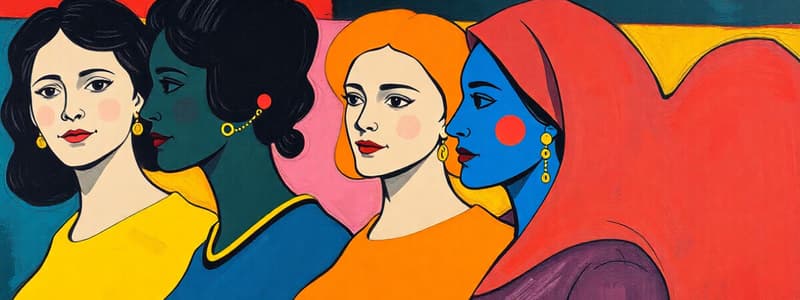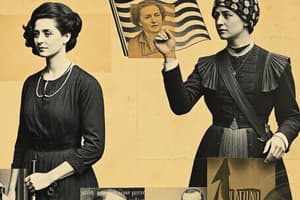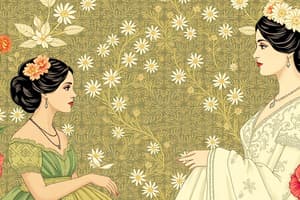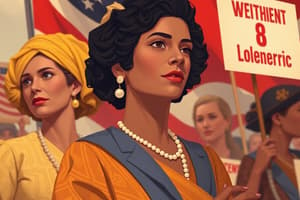Podcast
Questions and Answers
What was Mary Ann Cary's primary strategy for advancing the rights of Black women?
What was Mary Ann Cary's primary strategy for advancing the rights of Black women?
- Petitioning the government for economic reparations to address historical inequalities.
- Aligning with white suffragists, regardless of their racial views, to gain broader political support.
- Strategically supporting whichever political party would enfranchise Black women. (correct)
- Focusing solely on education and job training programs within Black communities.
Based on the text, what inherent contradiction existed within the women's suffrage movement during the late 19th century?
Based on the text, what inherent contradiction existed within the women's suffrage movement during the late 19th century?
- The movement's objectives were primarily economic, yet it framed its arguments in terms of civil rights.
- The movement's focus on urban areas neglected the needs of rural women.
- The movement's methods were largely non-violent, despite the violent opposition it faced.
- The movement's leaders often harbored prejudices against minority groups while seeking rights for themselves. (correct)
Which statement best reflects the perspectives of Elizabeth Cady Stanton and Susan B. Anthony, as described in the text?
Which statement best reflects the perspectives of Elizabeth Cady Stanton and Susan B. Anthony, as described in the text?
- They prioritized the voting rights of educated, American-born women over those of immigrants and African Americans. (correct)
- They sought to form alliances with diverse groups to create a more inclusive suffrage coalition.
- They actively campaigned against discriminatory practices targeting minority groups within the suffrage movement.
- They believed in universal suffrage, advocating for the voting rights of all citizens regardless of race or origin.
What was the prevailing attitude of some suffragist leaders, like Alice Paul, towards immigrants and minorities, according to the text?
What was the prevailing attitude of some suffragist leaders, like Alice Paul, towards immigrants and minorities, according to the text?
What systemic barrier to voting rights did many groups, including African Americans, Native Americans, and immigrants, face during the suffrage movement?
What systemic barrier to voting rights did many groups, including African Americans, Native Americans, and immigrants, face during the suffrage movement?
What primary role did wealthy and socially prominent women play in the suffrage movement?
What primary role did wealthy and socially prominent women play in the suffrage movement?
How did Julia Ward Howe connect the cause of women's suffrage to her earlier work?
How did Julia Ward Howe connect the cause of women's suffrage to her earlier work?
What was the significance of Julia Ward Howe forming 'a bridge between the world of society and the world of reform'?
What was the significance of Julia Ward Howe forming 'a bridge between the world of society and the world of reform'?
What characteristic enabled famous women to be effective in the suffrage movement?
What characteristic enabled famous women to be effective in the suffrage movement?
Celebrities today use their influence for social concerns. How did famous women in the past leverage their status during the suffrage movement?
Celebrities today use their influence for social concerns. How did famous women in the past leverage their status during the suffrage movement?
Flashcards
Celebrity Influence
Celebrity Influence
Celebrities can bring awareness and funds to social concerns via their fame.
Suffrage Celebrities
Suffrage Celebrities
Wealthy and well-known women who advocated for women's right to vote.
Organizational Skills
Organizational Skills
These women understood how to oversee and coordinate large households and resources.
Suffrage Funding
Suffrage Funding
Signup and view all the flashcards
Voting as Freedom
Voting as Freedom
Signup and view all the flashcards
Bias in Suffrage
Bias in Suffrage
Signup and view all the flashcards
Suffrage Movement Racism
Suffrage Movement Racism
Signup and view all the flashcards
Groups Denied the Vote
Groups Denied the Vote
Signup and view all the flashcards
Mary Ann Cary's Suffrage Stance
Mary Ann Cary's Suffrage Stance
Signup and view all the flashcards
Mary Ann Cary's Vision
Mary Ann Cary's Vision
Signup and view all the flashcards
Study Notes
- In 1840, Lucretia went to London with her husband , James Mott, for the World Anti-Slavery Convention.
- Male delegates didn't want female delegates there.
- The men voted that women couldn't speak and had to sit behind a curtained rail.
- Lucretia received more education than most girls of her time and was, by age fifteen, finished school and became a teacher.
- Quakers believed in treating boys and girls the same.
- Lucretia and other women built a fire in their hotel and burnt it through the night.
- That day, Lucretia saw that women were being denied a role in public life, realizing that men had to stop telling women what they could and couldn't do, and that laws and traditions would not change until women had a voice.
- At the convention, Lucretia met Elizabeth Cady Stanton a young newlywed who shared her outrage.
- In 1848, they met again at a friend's house in Seneca Falls, NY.
- A group of five women discussed the ways men controlled women's lives, deciding to hold a two-day meeting at the town's Wesleyan Methodist chapel.
- On July 19, 1848, more than three hundred people showed up.
- At the convention, the organizers presented a paper patterned after the Declaration of Independence called the Declaration of Sentiments and Resolutions.
- The document introduced the idea of women's equality with men and a woman's claim to all the rights of an American citizen.
- Oddly, a demand for the woman's vote was hotly debated, even by Lucretia, who believed focusing on it alone would take attention away.
- Sojourner Truth was the first African American woman to win a court case against a white person in the United States, in 1828, after suing a slave owner who had illegally sold her five-year-old son and winning his freedom.
- Sojourner began to speak out for suffrage.
- Sojourner called on her audience's background of faith to make her points.
- Her lack of education held Sojourner back in some ways, needing help reading train schedules, newspaper articles, and documents from her grandson, who served as her aide.
- Sojourner worked closely with Lucretia Mott and the early suffrage movement's other leaders, backing the cause and speaking publicly well into her eighties.
- Susan B. Anthony lived from February 15, 1820-March 13, 1906.
- Susan was scolded by a teacher who wouldn't let her learn long division.
- Susan's parents were Quakers who believed that men and women had equal abilities.
- Susan's father owned a cotton mill, but in 1837 he lost the business in a recession.
- At her school, Susan found that male teachers earned $10 a month, while female teachers were paid only $2.50.
- She began her activism with the temperance movement.
- At rallies, she wasn't allowed to speak because she was a woman.
- She vowed then and there that women should be equal.
- For almost five months, the women were on the road in a car named Saxon and nicknamed the Golden Flier, becoming a beloved symbol of the movement.
- Harry T. Burn [November 12, 1895-February 19, 1977] was only twenty-two years old when his vote won ratification of the Nineteenth Amendment.
- The amendment had passed in Congress in 1919, needing the approval of thirty-six states to become law.
- The State Senate passed the bill, but the House was locked in a 48-48 tie.
- Harry, who was representing an anti-suffrage district, got a letter from his mother urging him to "be a good boy" and vote for woman suffrage.
- Charlotte Woodward Pierce [1829?-1921] was a teenage glove maker who worked long hours for low pay.
- In 1848, she was intrigued when she saw the ad for the Seneca Falls convention.
- She traveled forty miles to the convention in a horse-drawn wagon from her home in DeWitt, New York, and signed the Declaration of Sentiments at the close of the convention.
- In 1915, at eighty-six years old, Charlotte marched in a suffrage parade down New York's Fifth Avenue.
- When the Nineteenth Amendment became law in 1920, Charlotte was the only signer of the Declaration of Sentiments still living, but at ninety-one years old, she was too ill to go to the polls.
- In the early 1800s, women couldn't vote, serve on a jury, or be a witness in court.
- Girls were rarely educated beyond elementary school, and, until 1837, not a single college that admitted men would admit women.
- If they worked, women generally were teachers or held menial jobs.
- Most people believed a woman should stay at home, caring for her husband and children.
- A married woman was the property of her husband, unable to own land, sign contracts, or keep her earnings, and couldn't even own her own clothes.
- Only a man could divorce and got sole custody of any children.
- In 1776, New Jersey's constitution allowed some unmarried women to vote, but that right was taken away in 1807.
- After the Fourteenth Amendment, the word "male" entered the Constitution in 1868, giving voting rights only to men.
- In 1857, Lucy and her husband moved into a home in Orange, New Jersey, that belonged to Lucy.
- When the first tax bill came a few months later, they refused to pay it—fifteen years before Abby Kelley staged her tax protest.
- Lucy, along with her husband and Julia Ward Howe, cofounded the American Woman Suffrage Association in 1869.
- The next year, she began publishing The Woman's Journal, a weekly paper that aired women's views.
- Back when men decreed that women belonged in the home, Lucy worked for a woman's right to take whatever place she chose in society.
- Sylvester Graham launched his innovative program for healthy living in 1832, believing you could prevent disease through veggies, little to no meat, and whole-grain wheat flour.
- He discouraged the use of coffee, tea, alcohol, and tobacco, and urged people to wear loose clothing, exercise, take cold baths, and open their windows.
- Lucy followed Graham's strict regimen.
- Carrie resigned as NAWSA president in 1904 to promote world suffrage, but her resignation was also personal—her second husband, George Catt, was dying.
- NAWSA called her back in 1915.
- The following year, Carrie organized an emergency convention in Atlantic City, NJ, to revive the dying movement.
- Part of Carrie's "Winning Plan" was to gain suffrage in NY State.
- On October 23, 1915, she led a parade of fifty thousand people down Fifth Avenue.
- By 1919, fifteen states had granted women full suffrage, and in another twenty states, women could vote in school board or local elections.
- On June 4, 1919, the Nineteenth Amendment finally made it through Congress.
- Suffragists honored Carrie with the gift of a sapphire-and diamond-studded brooch, and teachers had children bring pennies to school for the pin.
- Mary was a leader within the black women's suffrage movement at a time when most white suffragists weren't willing to work with African American women.
- For her entire life, Mary worked to improve the "crushed and blighted lives" of her people, becoming a pioneer of the modern civil rights movement.
- In the 1950s, when she was in her eighties, she led protests against department store restaurants that barred African Americans.
- Early leaders of the suffrage movement were white and wealthy.
- Mary worked tirelessly for African American suffrage and women's groups, as did Mary Ann Shadd Cary and Ida B. Wells-Barnett.
- In 1907, Harriot Stanton Blatch—Elizabeth Cady Stanton's daughter—formed the Equality League of Self-Supporting Women.
- On March 25, 1911, 146 workers at the Triangle Shirtwaist Factory in New York City died in a fire.
- White men wanted to keep the vote for themselves.
- White women weren't free from prejudice either.
- Frances Willard insulted African Americans.
- Elizabeth Cady Stanton scoffed immigrants and African Americans alike.
- Susan B. Anthony groused about those ignorant, alien peoples.
- Alice Paul dreamed of retiring to the country where were still "some American people left."
- Whole classes of people were judged unworthy of the vote, including Native Americans, people who couldn't read or write, African Americans, and immigrants.
- Suffragists were too often willing to play to people's racist beliefs in their pursuit of suffrage support.
- In 1878, Mary Ann tied the issue of the vote to the action of political parties
- Mary Ann believed that black women needed to take leadership roles in their communities with education and better living conditions.
- Julia's words to "The Battle Hymn of the Republic" called for justice for the enslaved.
- Famous women brought attention to the suffrage cause.
- These celebrities were generally actresses or wealthy women from families like Tiffany, Astor, Vanderbilt, Rockefeller, Barrymore, and Belmont.
- They enjoyed the limelight and knew their way around politics, business, and finance, holding fundraisers and financed suffrage conventions, parades, and offices that allowed suffragists to carry their message to a wide audience.
Studying That Suits You
Use AI to generate personalized quizzes and flashcards to suit your learning preferences.




